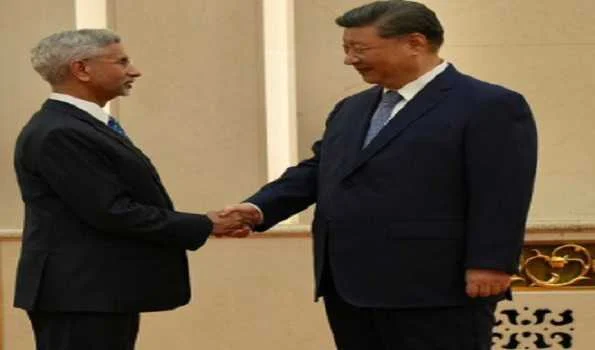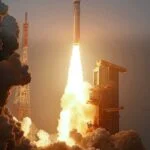By Arti Bali
New Delhi, July 17 . The “re-setting” in India-China ties should not be viewed in isolation, but as a strategic move driven by several converging geopolitical and geo-economic shifts, experts say.
This recalibration is evident in External Affairs Minister S. Jaishankar’s recent Beijing visit for the Shanghai Cooperation Organisation (SCO) meeting. This was Dr Jaishankar’s first visit to China after the 2020 Galwan incident, reflecting renewed engagement with China after years of tension.
Dr Jaishankar’s task was to finalise India’s agenda for the SCO Summit scheduled to be held on August 31-September 1. Prime Minister Narendra Modi is expected to travel to Tianjin for the Summit, his first such visit since the Galwan clashes in 2020.
These high-level diplomatic moves point to the roadmap of de-escalation set during Prime Minister Narendra Modi’s meeting with Chinese President Xi Jinping on the sidelines of the 2024 BRICS Summit in Kazan, Russia.
According to Anil Trigunayat, who served as Ambassador to Jordan, Libya and Malta, “Dr. Jaishankar’s visit is significant. It continues the momentum of bilateral re-engagement following the Kazan meeting. The recent visits by the Defence Minister and the NSA reflect the broader roadmap being pursued by India and China, with the SCO providing a parallel diplomatic platform.”
Beyond border tensions, the bilateral dialogue is unfolding against the backdrop of global strategic shifts—particularly weaponization of rare earth elements by China. Beijing’s restrictions on rare earth exports have triggered alarm worldwide. For India, which is aggressively pushing its Make in India initiative, access to rare earths is essential, not only for electric vehicles and smartphones, but also for military applications like the Akash and Astra missile systems.
“China is keen for visa facilitation and direct flights while India would want lifting of curbs on supply of rare earths etc,” Trigunayat said.
Dr Jaishankar emphasized “good progress” in restoring normalcy, attributing the shift to the resolution of friction along the LAC. Nonetheless, the journey towards trust and full normalization remains fragile.
The ongoing engagement is a calibrated shift in India’s China policy, one rooted in strategic autonomy, regional balance, and economic pragmatism. This new phase prioritizes de-escalation and de-induction of troops, with multiple rounds of discussions taking place between Special Representatives since the October 21 announcement of a renewed patrolling agreement.
As Anil Trigunayat noted, “China expects PM Modi to visit for the SCO Summit later in the year prior to which legacy issues post Galwan and various negative measures taken by both sides will have to be resolved including discussions between SRs on border issues “.
Faisal Ahmed, a leading voice on China’s global affairs and currently a professor of international business and geopolitics at the FORE School of Management, highlighted the persistent channels of communication between the two Asian giants.
“India and China have more to converge than diverge. Whether it is on trade, strategic or cultural cooperation, the two countries have never ceased bilateral dialogues. They have continued it through one or the other channel viz. military, and diplomatic, and at times through alternative mechanisms like the Track II.”
Pointing to the resumption of the Kailash Mansarovar Yatra and efforts to restore direct air connectivity as signals of growing cooperation, Faisal Ahmed said, “Not to forget that both leaders Prime Minister Modi and President Xi have also held direct talks through an outstanding mechanism of “informal summit” in 2018 and 2019.
During the recent visit of Chinese Vice-Foreign Minister to New Delhi, positive outcomes have emerged in terms of resuming the Kailash Mansarovar Yatra and resumption of direct flights between India and China.”
Despite historical mistrust, Ahmed believes economic interdependence and regional leadership aspirations are driving a new chapter in bilateral ties. “Both countries have a deep-rooted commitment to the Global South. The revival of informal summits between Xi and Modi could be key to removing the trust deficit.”
He rejected the notion that Trump’s tariffs are behind this thaw. “I don’t think Trump’s tariff factor is bringing India and China closer. China has been dealing firmly with the United States on the tariff issue and India too is negotiating it based on the idea that a possible trade deal should create a win-win situation, not unilateral gains for the United States”.
However, unresolved concerns remain. Regional flashpoints such as the South China Sea and Indian Ocean remain central to both countries’ strategic outlooks. “India’s position on freedom of navigation and its economic stakes in Vietnam’s EEZ oil blocks remain unchanged. And nonetheless, dialogue and diplomacy remain the way ahead to resolve all rudimentary and peripheral issues pertaining to the long-standing border dispute,” Faisal Ahmed explained.
India wants Beijing to take a stance on Pakistan-based terrorism, especially under the SCO’s stated mission to combat regional extremism.
“I think Prime Minister Modi’s presence in the SCO Summit will provide a much-solicited leadership not only to the region-building efforts in the SCO, but also to a future roadmap for India-China cooperation. There are several SCO level concerns e.g. counterterrorism, transnational organised crimes, cybersecurity threats, regional connectivity issues, etc. which also need to be addressed, he added.
Referring to the Pahalgam terror attack, Jaishankar reminded China, “The main objective that SCO was founded for, is to combat the three evils of terrorism, separatism and extremism. The Pahalgam terror attack was deliberately done to undermine the tourism economy of Jammu and Kashmir while sowing seeds of a religious divide.”
Anil Tribgunyat said, “Moreover Chinese stance on Pakistan based terror attacks on India will have to be raised especially in the SCO meeting since the fundamental objective of the organisation is to counter terrorism.’’
. . RB










